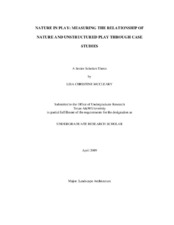| dc.description.abstract | A strong link has been established between children playing in nature and improved physical and emotional health. The intriguing biophilia hypothesis suggests that humans are hardwired with an innate love of nature and that spending time in it is vital for well-being. As we understand nature’s ability to enhance health and alleviate behavioral disorders, the question is what factors of nature optimize this connection and can be incorporated into children’s everyday environments through design guidelines.
Case studies are given for three play spaces containing little nature, some nature, and complete nature in Bonn, Germany. The city has a rich environment and culture with a historic dedication to caring for the environment that made it ideal for a comparison of the presence of nature in play spaces. Methods of research included standard case study procedures as given by Clare Cooper Marcus, Carolyn Francis, and Francis Mark. The narrow time frame of two weeks in October for data collection posed a limitation to the research. Three case studies document play spaces with little nature, some nature, and complete nature. The Auerberg neighborhood playground (little nature) was not well maintained in a space located near apartments for a low socioeconomic class. The Hofgarten urban playground (some nature) contained a well-maintained playground in an urban forest. The Naturpark Rheinland (complete nature) involved a trailhead connecting the neighborhood to the forest where children would gather and play.
The results showed that the percentage of natural play compared to all play that occurred in the Auerberg neighborhood playground (12.0%) and the Hofgarten urban playground (11.1%) were nearly equal while the hypothesis suggested the Hofgarten playground would have more natural play. One reason for the unanticipated result is that the maintenance level was high so that the ground plane was cleared of attractive elements of nature, such as leaves and fallen branches. The case studies suggest that topography and the ground plane may have a greater influence on natural play than the presence of overhead tree canopy. | en |


